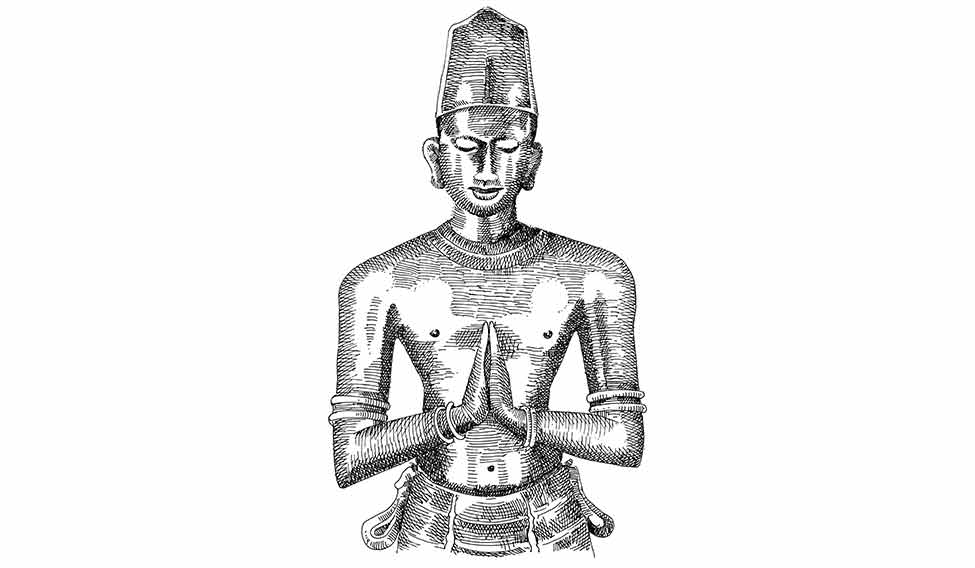The Vijayanagara Empire was known by several names like ‘The Forgotten Empire’, ‘The Never-To-Be Forgotten Empire’, ‘Segmentary State’ and ‘Military State’. The famous Hampi was its capital city, and travellers drew parallels between Hampi and Rome. The empire, which existed from AD1336 to 1565 generated great interest right from its beginning, and is still attracting in large numbers scholars and travellers alike. Among the rulers of four dynasties of the empire, Krishnadevaraya of Tuluva dynasty, who was in power from AD1509 to 1529, is the most popular.
Known as a successful soldier and a good administrator, Krishnadevaraya was an ambitious king. When he assumed power, he faced many threats from internal and external enemies. He quelled the attack on Vijayanagara by a united front of Shahi sultans and expanded his empire by conquering several kingdoms in south and north India. His fame extended up to Simhala. Shahi sultans were continuously trying to establish their hold over the empire which was situated in the fertile Tungabhadra-Krishna Doab region. The fact that Krishnadevaraya was able to exercise control over the region throughout his 20-year rule is quite noteworthy. He had well-established trade and commercial relations with the Portuguese from whom he bought horses and built his army. He extended his reign over the coastal region spanning around 2,500 kilometres and is said to have maintained good commercial contact with foreign countries.
It is Krishnadevaraya who organised the empire comprising several smaller and bigger provinces by setting up provincial administration and a strong military. He could achieve all this within a short span of time with the help of his 10-lakh-strong standing army. It is said that the organisation of the army was based on the feudal system. Travellers have written about the annual review of the army during the Dasara festival. Portuguese travellers like Barbosa, Nuniz, Paes and others who visited the empire during his tenure kept a record of the Navaratri celebrations and other cultural events and rituals of those times.
There are several references to Krishnadevaraya’s tolerance towards all languages, sects and religions. He gave liberal grants and endowments to Kanchi, Tirupati, Srisailam, Ahobilam, Srirangam and several other temples and pilgrim centres. He also encouraged literature, music, art, architecture and other cultural forms. Sanskrit poets and scholars of his court were known as ‘Ashtadiggajas’. Vyasaraya Rajaguru, the chancellor of Vijayanagara University and many Dasas of Dasakuta tradition lived in his time. Krishnadevaraya was proficient in Sanskrit, Kannada and Telugu and was a scholar himself. He wrote a play called Jambavathi Kalyana in Sanskrit and a work of poetry called Amuktamalyada in Telugu.
The personality, achievements and rare qualities of Krishnadevaraya inspired the coinage of many epithets to praise him like 'Kannada Rajya Ramaramana', 'Andhrabhoja', 'Yavana Rajya Pratishtapanacharya' and 'Chatussamaya Samu'. It would not be off-the-mark to say that Vijayanagara Empire and Krishnadevaraya remain relevant to the scholars even today.
Govindaraju is professor of history, Kannada University, Hampi.
Tenali Rama
Just in jest
Krishnadevaraya's court consisted of several poets and scholars and eight of them, known as ‘Ashtadiggajas’, stand out. Tenali Rama was one of them. He has been referred to as 'Tenali Ramanna', 'Tenali Ramakrishna' and 'Tenali Ramabhadra'. His poetry, which earned him the title of ‘Vikatakavi’, was known for its unsurpassed wit and humour. His intelligence, presence of mind and sharp wit became talk of the town. He was clever enough to find solutions to the political problems of the day, which endeared him to Krishnadevaraya.
Tenali Rama was proficient in several languages. He was also a scholar of great repute. He has written Udbhatacharya Charitamu and Panduranga Mahatyamu in Telugu. Even today Tenali Rama’s name and stories are quite popular in children’s literature and many movies and TV serials have been made on him.
Sayana
Scholar’s musings
Sayana or Sayanacharya’s name comes up time and again in the cultural history of Vijayanagara. The association of Madhava’s name with that of Sayana had created confusion among scholars but research suggests that the two were brothers. There are references to hundreds of works by Sayana and Madhava. Sayana was considered to be one of the foremost Sanskrit scholars of his time. He was a court scholar of the Vijayanagara Empire for more than 40 years. Sayanacharya’s name figures prominently in Sanskrit literary history.
The Sudhanidhi or Sarasangrahas authored by him are considered milestones to date. Among them, the Subhashita sudhanidhi, Purushartha sudhanidhi, Alankarika sudhanidhi, Ayurveda sudhanidhi, Yagnatantra sudhanidhi, Prayashchitta sudhanidhi and Dhatuvritti are noteworthy. Sayana’s debates on Vedabhashyas have attracted scholarly attention. He has also written commentaries on several literary works of Vedic times. Krishna Yajurveda Samhita, Tittiriya Brahmana, Rigsamhita, Tittiriya Aranyaka, Aitareya Brahmana, Aitareya Aranyaka, Sama Samhita, Tandya Brahmana, Satapatha Brahmana and Atharvaveda are important among them. Sayana is said to have produced these works from AD1360 to 1380 during the reign of Bukkaraya and Harihara II and it is said that Harihara II assumed the title ‘Vaidika Marga Sthapanacharya’ because of him.





